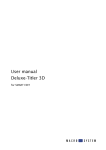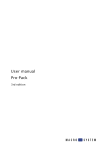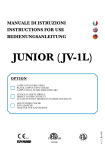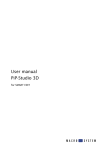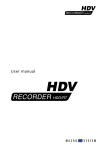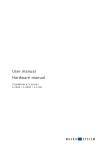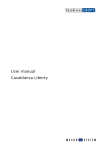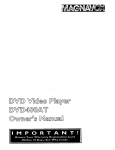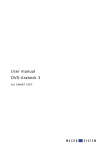Download Casablanca Claro User manual
Transcript
User manual Hardware manual 5th edition The following products carry the CE seal of conformity on the basis of the guidelines 89/336/EWG of the Commission of the European Community from 29. April 1991 for the alignment of legal regulations in the signatory states concerning communications devices, including mutual recognition of their conformity. The following products are confirm to the low voltage directive 2006/95/EC. These digital video editing systems are meant for use with hard-drives carrying the CE seal of conformity. This statement is given in responsibility for the manufacturer: MacroSystem Digital Video AG, Schöllinger Feld 28, 58300 Wetter, Germany Remarks on Safety These devices conform to the relevant safety regulations for computer equipment, including electrical office machines. In case you are in doubt as to permission regarding setup in the intended surroundings, please contact your dealer or our service department. • Transport the device only in the original packing or in other appropriate packing that guarantees protection against sudden movements or impacts. • Condensation may result if the device is set up for operation after having been in colder surroundings. You should wait about 2 hours to let the device become dry and attain the temperature of the operating location. • Read the notes below "Location Environment" when setting up and before operating the device. • Check that the operating voltage indicated on the type label is the same as the power outlet. • The equipment is intended for connection to TN power system and IT power system for Norway only (phase to phase 230V). • The equipment is a class 1 equipment and must be connected to an earthed outlet. • This device is equipped with a safety-approved power cable and may only be connected to a grounded shockproof socket. • The ON/OFF switch does not electrically separate the device from power. For complete separation from power the power cable must be pulled from the power outlet socket. • Make sure that the power connector on the machine and the room shockproof socket are easily accessible. • Place the power cables so that they are not a danger (tripping) and will not be damaged. • Data lines must not remain connected during electrical storms. • In emergencies (e.g. damaged casing, operating elements, or power line, liquid poured on the device, or foreign substances) you must turn off the device immediately, pull the power plug, and contact your dealer or our service department. • Only qualified and authorized personnel may repair the device or install extensions. Unauthorized opening and improper repairs can mean real danger for the user. In such cases the guarantee is no longer valid. • The equipment was evaluated for use in a maximum ambient temperature of 35°C. • System extensionsmust be conform to the requirements and rules for safety, electromagnetic interference, and telecommunications end devices. Installing other extensions may violate these requirements and rules, or damage the system. Your dealer or our service department can tell you which system extensions are allowed. • The unit contains a Lithium battery. It may only be removed or exchanged by authorized personnel. Incorrectly replacing the battery may lead to the battery exploding. Replace the battery only with the same or equivalent type recommended by the manufacturer. Dispose of used battery according to the manufacture‘s instructions. Location Environment • Make sure that the machine is operated at a location temperature of 10 to 25° centigrade. • The location must be dry. Air humidity must not be more than 80% and must not be condensing. •Make sure that there is sufficient circulation of the air in order to prevent thermal buildup. Do not cover up the machine. If you mount the machine in a rack make sure that any warm air can directly be released. Generally, the room temperature (e.g. in the rack) should not exceed 30° Celsius. • Do not set up the machine on carpeting, blankets, or the like. Do not set up the machine near curtains, etc., because this entails the danger of blocking the ventilation ducts on the machine. • Do not set up the machine near heating or the like, and not in locations that are overly dusty, affected by direct sunlight, mechanical vibrations, or where the machine can be knocked. • The machine should be in a horizontal position when being operated. Do not set up the machine on an incline. • Keep the machine at a distance from devices that emit a strong magnetic field (microwave ovens, large loudspeakers). Proper waste disposal of this product (regulation of electronic device disposal): (Applies to countries of the European Union and other countries with similar waste collection systems) Please dispose of this device separately from other waste in order to prevent damage to the environment or human health by uncontrolled waste disposal. Recycle the device to allow for lasting recycling of recourses. Private users should contact the dealer they purchased the product from or contact the responsible public authorities to find out how to dispose the product in an environment-friendly way. Industrial or commercial users should contact their suppliers and check the terms and conditions of the purchase contract. This product may not be disposed together with other commercial waste. Casablanca © Copyright 2002-2007 MacroSystem Digital Video AG All product names mentioned are registered trademarks of the corresponding firms. This document is protected by copyright. Any change, copy, translation, or distribution without prior permission of the author is prohibited. No liability is assumed for information in this document. We reserve the right to make technical changes. FCC Class A Compliance Statement (Claro, Prestige, Prestige PLUS, Kron, Kron PLUS, Gymnos) This device complies with part 15 of the FCC Rules and meets all requirements of the Canadian Interference-CausingEquipment Regulations (ICES-003). Operation is subject to the following two conditions: (1) This device may not cause harmful interference, and (2) this device must accept any interference received, including interference that may cause undesired operation. The following statement applies to the products covered in this manual, unless otherwise specified herein. The statement for other products will appear in the accompanying documentation. This equipment has been tested and found to comply with the limits for a Class A digital device, pursuant to Part 15 of the FCC Rules and the Canadian Interference-Causing Equipment Standard ICES-003 for digital apparatus. These limits are designed to provide reasonable protection against harmful interference in a residential installation. This equipment generates, uses, and can radiate radio frequency energy and, if not installed and used in accordance with the instructions, may cause harmful interference to radio communications. However, there is no guarantee that interference will not occur in a particular installation. If this equipment does cause harmful interference to radio or television reception, which can be determined by turning the equipment off and on, the user is encouraged to try to correct the interference by one or more of the following measures: • Reorient or relocate the receiving antenna. • Increase the separation between the equipment and receiver. • Connect the equipment into an outlet on a circuit different from that to which the receiver is connected. Consult the dealer or an experienced radio/T.V. technician for help. Macro System US is not responsible for any radio television interference caused by unauthorized modifications of this equipment or the substitution or attachment of connecting cables and equipment other than those specified by Macro System US. The correction of interference caused by such unauthorized modification, substitution or attachment will be the responsibility of the user. The use of shielded I/O cables is required when connecting this equipment to any and all optional peripheral or host devices. Failure to do so may violate FCC rules. This Class A digital apparatus meets also all requirements of the Canadian Interference-Causing Equipment Regulations (ICES-003). FCC Class B Compliance Statement (Avio, Renommee, Renommee PLUS) Information to the User NOTE: This equipment has been tested and found to comply with the limits for a class B digital device, pursuant to Part 15 of the FCC Rules and meets all requirements of the Canadian Interference-Causing Equipment Regulations (ICES-003). These limits are designed to provide reasonable protection against harmful interference in a residential installation. This equipment generates, uses and can radiate radio frequency energy and, if not installed and used in accordance with the instructions, may cause harmful interference to radio communications. However, there is no guarantee that interference will not occur in a particular installation. If this equipment does cause harmful interference to radio or television reception, which can be determined by turning the equipment on and off, the user is encouraged to try to correct the interference by one or more of the following measures: • Reorient or relocate the receiving antenna. • Increase the separation between the equipment and receiver. • Connect the equipment into an outlet on a circuit different from that to which the receiver is connected. • Consult the dealer or an experienced radio/T.V. technician for help. MACROSYSTEM US is not responsible for any radio or television interference caused by unauthorized modifications of this equipment or the substitution or attachment of connecting cables and equipment other than those specified by MACROSYSTEM US. The correction of interference caused by such unauthorized modification, substitution or attachment will be the responsibility of the user. The use of shielded I/O cables is required when connecting this equipment to any and all optional peripheral or host devices. Failure to do so may violate FCC and ICES rules. Table of contents Chapter 1: Introduction ........................................................................................................... 7 1.1 Congratulations!.............................................................................................. 7 1.2 The system....................................................................................................... 8 Chapter 2: Installation ............................................................................................................. 9 2.1 What‘s in the package ? .................................................................................. 9 2.2 How to connect your system.......................................................................... 9 Casablanca Claro...................................................................................... 10 Casablanca Avio....................................................................................... 10 Casablanca Gymnos ................................................................................ 11 Casablanca Prestige (PLUS) .................................................................... 11 Casablanca Renommee ........................................................................... 12 Casablanca Renommee PLUS................................................................. 13 Casablanca Kron (Plus)............................................................................ 13 Casablanca Solitaire ................................................................................ 13 Casablanca Solitaire PLUS ...................................................................... 14 2.3 Card reader in Casablanca Claro ................................................................... 18 2.4 Casablanca Claro - setting up......................................................................... 18 2.5 Powering up your editing system.................................................................. 19 2.6 Removing the SmartMedia card .................................................................... 19 2.7 Information on hard-disks .............................................................................. 19 2.7.1 Casablanca Gymnos, Prestige and Renommee ......................... 19 2.7.2 Casablanca Solitaire ..................................................................... 19 7 Chapter 1: Introduction (North America) Monday - Friday 9a.m. - 5p.m. (Mountain Standard Time) 303-801-1010 1.1 Congratulations! Congratulations on the purchase of your new system! We thank you for the confidence and trust you have shown us, and we hope that the system will meet your expectations. This manual has been devised for all current MacroSystem equipment running Smart Edit. It will help you with any connection and installation issues. Feel free to contact us to ask further questions or to give us suggestions. Whenever you contact us, please have your customer number or the serial number of your system device at hand so that we can help you more quickly. Address : MacroSystem Digital Video AG Postfach 020240 58290 Wetter Germany E-Mail Support [email protected] (Germany) [email protected] (North America) [email protected] (N.A.) [email protected] (N .A.) Fax Support +49 (0)2335/960-110 303-801-1058 (Germany) (NorthAmerica) When calling, please have the serial number of your device at hand. Up-to-date information on MacroSystem products and our sales department can be found on the Internet. MacroSystem US 5485 Conestoga Court Boulder, Colorado USA 80301 Phone 0 +49 (0)2335/960-0 303-440-5311 Outside of these times you can email or fax us. Messages received in this way are handled during business hours. Please visit our Website: http://www.macrosystem.de (Germany) ttp://www.macrosystem-louvre.de http://www.macrosystem-enterprise.de http://www.casablanca.tv (North America) (Germany) (NorthAmerica) 1.2 The system E-Mail [email protected] [email protected] (Germany) (North America) Fax 0 +49 (0)2335/960-100 303-440-5322 (Germany) (North America) Phone Support If you have special technical questions, you can call our technical support hotline: (Germany) Monday -Thursday from 10.00 to 17.00 hours Friday 10.00 to 16.00 hours +49 (0)2335/960-112 Your system is a complete system for digital video editing that is superior in data transfer rate and picture quality to the requirements of the DV system. The system is operated by a trackball (supplied in the package) and the user interface has been designed to be as easy to use as possible. Software installation is almost fully automatic and requires only basic user input. The impressive hardware performance of the system is ideal for full digital video editing with MiniDV, (although of course analog equipment is easily compatible as well.) DV devices (camcorders, DV decks, etc.) can be connected through the DV (i-Link) port. This means that digital video editing has practically 8 no loss, (especially when using digital DV cameras and decks). Optimally, to avoid analog losses altogether, you should record in and out using the MiniDV format. But it is also possible to input from a DV camera and to record out through YC (S-video) CVBS (RCA) or SCART (in Europe) to a VHS, SVHS, or Hi8 recorder, and still get phenomenal results. It is not necessary to install any additional components whatsoever (such as computer boards, memory modules, etc). Your system is a complete system offered by one company – hardware, software, and video technology have been developed in Germany by MacroSystem Digital Video AG. This manual has been devised for all current MacroSystem systems running Smart Edit. Any specific differences between machine types are noted in the respective part of this document. 9 Chapter 2: Installation Important information on connecting your systems: 1. Before connecting your system, please make absolutely sure that you first disconnect all the aerial/cable-TV or satellite reception cables from the television set, from the video recorder and from the set-top box. 2. Next, connect up all the necessary video and audio cable connections between your system and the TV monitor or video recorder. 3. Only after you have carried out all of these steps should you plug the mains power supply cable into the device. 4. Finally, you should reconnect the aerial/cableTV or satellite reception cables back into their original positions on the television set, video recorder and set-top box. These steps are intended to protect the high quality video inputs and outputs against damage. Any damage resulting from these instructions being ignored is not covered by the guarantee. Several steps are necessary before you begin to use the system, and you should allow yourself some time for this setup. This part of the manual explains the necessary installation procedures. After you have unpacked and connected the system, you may want to turn it on and try it out right away. This is simple to do, but there are other cabling options that depend on the rest of the equipment in your studio. Therefore, please read the description of the individual steps carefully! 2.1 What's in the package? The following items are included in the package: 1. The editing system 2. Trackball 3. installation SmartMedia card or CD/DVD 4. SmartMediaCard or DVD with additional soft- ware 5. User manual 6. Connecting cables 7. Registration card (8. Depending on machine type, a set of keys for the hard-drive drawer) (Depending on the country that you live in, there may be other pieces of literature or other items included, so be sure to inspect the contents of your package carefully.) If some items are missing, please contact the dealer where you bought the unit. Please save the packaging in case you ever have to transport your unit or send it to the manufacturer. The packaging has been specially designed for the system and is very sturdy. (MacroSystem is not responsible for damage incurred from improper packing during shipping). 2.2 How to connect your system In addition to your TV monitor and/or VGA monitor, you will need a video input device and a recording machine, usually your video camera. On the following pages, you can see the CASABLANCA CLARO (front, rear view) CASABLANCA AVIO (rear view) CASABLANCA GYMNOS (front, rear view) CASABLANCA PRESTIGE (front, rear view) CASABLANCA RENOMMEE (front, rear view) CASABLANCA KRON (rear view) and CASABLANCA SOLITAIRE (front, rear view). The explanations of the single (numbered) ports and connections can be read in the appendix. 10 The devices that are pictured here are a selection of the available models. For this reason your system might look somewhat different, though the functions are the same. CASABLANCA CLARO, front and rear view CASABLANCA AVIO, rear view 11 CASABLANCA GYMNOS, front and rear view CASABLANCA PRESTIGE (PLUS), front and rear view 12 CASABLANCA RENOMMEE, front and rear view 13 CASABLANCA RENOMMEE PLUS, rear view CASABLANCA KRON (PLUS), rear view CASABLANCA SOLITAIRE, front and rear view 14 CASABLANCA SOLITAIRE PLUS, rear view 15 Front CASABLANCA PRESTIGE (PLUS), RENOMMEE (PLUS) and SOLITAIRE (PLUS): (A) SOLITAIRE: display This display on the frontpanel is used for various functions, depending on the current menu. (B) SOLITAIRE: access panel Behind this access panel are the front ports of the CASABLANCA SOLITAIRE. Please do not open it by hand. Read the following text! (C) SOLITAIRE: Open By softly touching this sensor button, the lid (see item (B)) opens and offers you free access to the front ports. Beforehand please make sure, that your system is on stand-by even running - power must be present. If you want to close the lid (e.g. for transport), please pull out the cables and touch the button "Open" anew, making the access panel close automatically. record commentary. This is a stereo input with a 3.5 mm jack. You can use an adapter if your microphone has a 6.3 mm jack plug. You can also connect a mono microphone, but be sure to set the corresponding Mono mode in the Audio Record screen. (5) DV IN/OUT This "DV" connection serves as input and output for MiniDV/DV decks, cameras and other equipment with DV connectability, such as PC systems with firewire cards, and offers optimum quality. Be sure that only one DV device is connected at any time, or errors may occur. Front CASABLANCA CLARO: (16) 3 USB This USB port should be used for the included trackball, the other USB ports can be used for further hardware options (e.g. PowerKey Option, etc.). (D) SOLITAIRE: Power button By softly touching this sensor button, the system is switched on. (21) On/Off button Powers the editing device up or down when pressed. (E) SOLITAIRE: Backup This button has no direct reference to the ports of your CASABLANCA SOLITAIRE. Please read about this function in Chapter 8 in the SMART EDIT manual: "HD Backup-System“. (22) LED A light emitting diode that lights up in green when the system is in use. (1) Video IN (RCA) This CVBS (RCA) input is used to connect (via RCA cables) from a VHS or Video8 input device. (2) L/R Audio IN (RCA) To capture audio you must connect the cable to the Audio IN L and R inputs. Sources for mixing (e.g. CD player) can also be connected here when needed. (3) S-Video IN (YC) If you have a Hi8 or SVHS input device, then you should use the YC (s-video) input because picture quality will be better than CVBS (RCA). (4) Mic. IN You can connect a microphone to this input to (23) LED This LED flashes yellow while the unit is powering up and during any hard-drive activity (for example during recording, playback, trimming...) (24) Drive switch Pressing this switch when the Casablanca Claro is in the ON status, opens or closes the above CD/DVD drive. (25) lower front panel The ports found behind this flap panel are not used. 16 Rear view CLARO, AVIO, GYMNOS, PRESTIGE (PLUS), RENOMMEE (PLUS), KRON (PLUS) & SOLITAIRE (PLUS) (4) Mic. IN You can connect a microphone to this input to record commentary. This is a stereo input with a 3.5 mm jack. You can use an adapter if your microphone has a 6.3 mm jack plug. You can also connect a mono microphone, but be sure to set the corresponding Mono mode in the Audio Record screen. (6) Power connection Here you connect the machine to the power line (220-240 V in most parts of Europe, 115 V in North America). Connect the supplied power cable to the power plug on the rear side of the machine and then connect the other end to the power outlet. Never turn off the machine by pulling the power cable from the electrical outlet or by cutting power between the machine and the outlet. Always use the switch on the front side of the system, or use the “Off” button in the Main Menu screen, or data may be lost. (7) Video/TV Monitor RGB (Europe only) (The following information is not applicable in North America.) Connect your TV monitor (for a computer monitor see port (17) or Chapter 6 "VGA mode" in the SMART EDIT manual) to this SCART port. For televisions supporting RGB in addition to CVBS, the user interface appears very sharp. Be sure to choose the correct AV input on your television. (If your TV does not have a SCART port, then connect it through the CVBS(RCA) input or through the antenna socket of the VCR. This configuration results in lower picture quality. If you normally do not connect the VCR to the TV through the antenna socket, then you must first program the video recorder channel in your television.) North America customers must use the euroscart adapter with the AVIO to get SVHS out. (8) Ethernet This port is an interface for exchanging data with other devices (e.g. computers). Please read chapter 9 "Ethernet-Transfer" in the SMART EDIT manual. Please note: On Solitaire, use only the labelled port (found beneath the DV port) for Ethernet-Transfer. (9) S-Video OUT (YC) You can connect VCR (Hi8, SVHS, or MiniDV) to this port to output to tape once your project is completed. If your video recorder supports a YC (S-video) signal, then you should use this as your output, because YC (S-video) is superior to CVBS (RCA). North America customers must use the euroscart adapter with the AVIO to get SVHS out. (10) S-Video IN (YC) You can use this input instead of the front input in order to connect your Hi8, SVHS, or MiniDV camera. Ideally, MiniDV should input via the DV port, however, the YC (S-video) port may occasionally be used if the footage needs to be corrected with the Brightness, Contrast and Saturation controls in the Video Settings screen. (11) Video OUT ( RCA) Here you can connect a VHS vcr, Video8 recorder or TV. (12) Video IN (RCA) You can use this input to connect your VHS or Video8 input device as an alternative to the front inputs. (13) L/R Audio OUT (RCA) The audio outputs are here, and should be used to output to your VCR or TV. (14) L/R Audio IN (RCA) These audio inputs can be used instead of the front inputs. (15) DV (IN/OUT) This "DV" port (optional for CASABLANCA AVIO) can be used to connect your MiniDV/DV recorder or your camera and other equipment with DV connectability, such as PC systems with firewire cards. (16) 3 USB One of the USB ports should be used for the included trackball, the other USB ports can be used for further hardware options (e.g. PowerKey Option, etc.). For users wishing to connect more than the supplied USB devices, we offer a quadruple HUB. The HUB is a distributor supplied with a support (for horizontal mounting), a USB connecting cable (length 1.5 meters), and an AC adapter. 17 (17) VGA You can use the VGA port to connect a computer monitor in addition or alternatively to your TV monitor. (see Chapter 6 "VGA Mode" in the SMART EDIT manual). CASABLANCA AVIO’s VGA option can be purchased separately. Instead of using a television with the CASABLANCA CLARO, you can use this VGA port to connect a computer monitor (also a flat screen). However, you cannot run the system with both screens at the same time. For use with the Casablanca AVIO, the VGA-Option must be purchased separately. (18) SCSI Use the SCSI connector to connect external SCSI hard-drives or other SCSI equipment. (19) Serial port Here you can see the serial port. (20) PS-2 port Should the included trackball make use of the PS-2 connector, use the PS-2 port on the rear side of the unit to connect. For users who would rather work with a PC mouse, simply connect the mouse instead of the trackball. Please contact your dealer to make sure – not all mouse types work with Casablanca. Important note: Never disconnect cables from the system while the machine is on. Always turn off the machine before you disconnect/ reconnect cables! 18 The following is an example of a setup showing the cable connections of CASABLANCA CLARO: 2.3 Card Reader on CASABLANCA CLARO A card reader is integrated into the front of your system. The card reader also has a USB port and supports all popular memory cards used in digital cameras. Furthermore, the “Card Drive” software that you need for this is included and is already installed on the system (see “System settings”, “Install product”). To open the front cover of the card reader, press down on the bumpy area at the top right so that the flap opens outwards. You can now insert your memory card into the relevant slot – when doing so, make sure the card is facing in the proper direction. To find out how to then import photos from the memory card or export photos from the CASABLANCA CLARO onto the memory card, please read the online help (i-button) of “Photo Transfer” or download the respective pdf file from our website for more information. 2.4 CASABLANCA CLARO - setting up You can set up your system either horizontally (as depicted) or vertically. If you choose the latter variant, please make sure that when you insert a CD/DVD, you place it correctly into the special recess so that it cannot fall out when you close the drive! The Casablanca Claro is supplied with four feet located on the underside of the unit. To set up the system vertically, please detach the feet by moving them into a position in which you can 19 see the two side clips. Then carefully press on the clips from both sides at the same time and pull out the feet. Afterwards, push the feet into the four special slots on the right or left side of the unit, depending on your preference. Then turn the feet in the desired direction. 2.5 Powering up your editing system If you are working with CASABLANCA CLARO, AVIO, GYMNOS, PRESTIGE, RENOMMEE or KRON, you have to press the Power-button. CASABLANCA SOLITAIRE requires touching the sensor-controlled button in the right lower corner. 2.6 Removing the SmartMedia card After installation (see chapter 2.3 in the SMART EDIT manual) has been carried out, remove the card. If you are using CASABLANCA AVIO, simply remove the card. Users of CASABLANCA PRESTIGE, KRON and SOLITAIRE should press the card further into the drive so that it automatically comes out again. Now remove the card. 2.7 Information on hard-disks CASABLANCA GYMNOS, PRESTIGE, RENOMMEE and SOLITAIRE offer the possibility of using multiple hard-drives. If you want to use a new hard-drive, insert it into the hard-drive slot (in its cradle), found in the middle of the unit’s front panel. If, by mistake, you have started the system without a hard-drive, it will warn you about this with the ambulance symbol. 2.7.1 CASABLANCA GYMNOS, PRESTIGE and RENOMMEE When transporting your system, take care to lock the hard-drive bay so that the drive cannot fall out. In order to remove the hard disk drawer from the powered down device, unlock it by positioning the key in its horizontal position and pull the drawer out of the unit. To pull out the key, you must first return it to its original position (vertical). In order to lock the drawer securely back in the device, make sure that the lock is in the vertical position and then insert the drawer. Once the drawer is inserted back in the device, press firmly on the lock. Since it is a spring lock, you will hear the drawer click into place automatically. This is the only way of ensuring that the drawer (which must form a tight fit with the housing to prevent interference and rattling) cannot fall out and be damaged during transportation. 2.7.2 CASABLANCA SOLITAIRE The system is shipped with a non exchangeable backup drive, integrated inside the system (see chapter 8: "HD Backup-System" in the SMART EDIT manual) and an exchangeable system hard drive. You can remove the system hard drive from the powered down unit by pressing the outer parts of the hard drive drawer face with your thumb and forefinger, in order to grab the middle part of the drawer. Now pull. To insert a new drawer including a hard drive, just insert it into the upper bay (IDE 0). Please make sure that the connector found on the rear is located on the bottom side! You should hear a clicking sound when the hard-drive snaps in. The lower disk bay (IDE 1) can be used to add another system hard drive. 314-02/07




















